13 Best Herbal Teas For Knee Pain
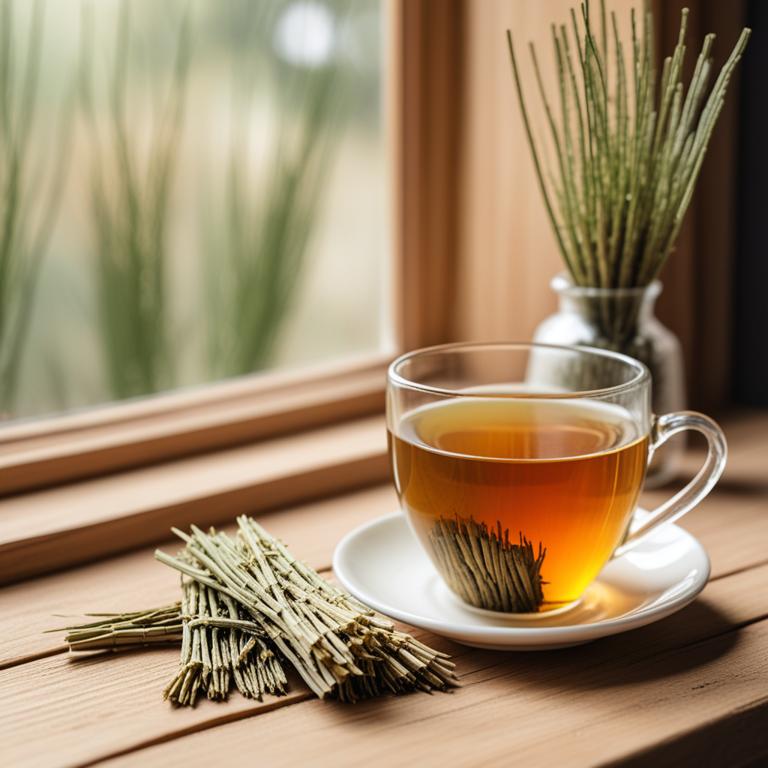
Herbal teas for knee pain are a natural remedy used to alleviate discomfort and inflammation associated with knee pain, a common ailment affecting millions worldwide.
These teas work by reducing inflammation, improving circulation, and relaxing muscles, which helps to ease the pain and discomfort.
Examples of herbal teas that can treat knee pain include ginger tea, which reduces inflammation and soothes the muscles; turmeric tea, which contains curcumin that has anti-inflammatory properties; willow bark tea, which contains salicin, a natural pain reliever; peppermint tea, which relaxes muscles and improves circulation; chamomile tea, which reduces inflammation and promotes relaxation; rosemary tea, which improves circulation and reduces pain; and meadowsweet tea, which contains salicylic acid that reduces pain and inflammation.
By incorporating these herbal teas into their daily routine, individuals can find natural relief from knee pain without relying on pharmaceuticals.
Related Study
According to "Current drug discovery technologies", teas for knee pain, such as green tea, may be effective in providing relief due to its antinociceptive effects, attributed to antioxidant and anti-inflammatory properties, specifically attributed to Epigallocatechin -3-gallate (EGCG).
Below there's a list of the 13 best herbal teas for knee pain.
Table of Contents
- 1. Zingiber officinale teas
- 2. Curcuma longa teas
- 3. Glycyrrhiza glabra teas
- 4. Cinchona officinalis teas
- 5. Ginkgo biloba teas
- 6. Urtica dioica teas
- 7. Equisetum arvense teas
- 8. Angelica sinensis teas
- 9. Achillea millefolium teas
- 10. Silybum marianum teas
- 11. Aloe barbadensis teas
- 12. Echinacea purpurea teas
- 13. Corydalis yanhusuo teas
Also, you may be interested in...
Today Free Bonus!
The Ultimate Herb Drying Checklist
(For Long-Lasting Powerful Medicinal Effect)
How to easily dry herbs that don't mold and that keep their strong medicinal power for more than 1 year.
1. Zingiber officinale teas

Zingiber officinale teas, derived from the rhizome of the ginger plant, have been traditionally used to alleviate knee pain due to their anti-inflammatory and analgesic properties.
The bioactive constituents, such as gingerols and shogaols, help to reduce inflammation and relieve pain by inhibiting the production of pro-inflammatory enzymes and mediators.
By consuming Zingiber officinale teas, individuals can experience relief from knee pain, as the bioactive compounds work to reduce swelling and promote healing in the affected area.
The benefits of using Zingiber officinale teas to treat knee pain include reduced pain and inflammation, improved joint mobility, and a natural, non-invasive approach to managing this common ailment.
Related Study
According to "Arthritis and rheumatism", Zingiber officinale teas for knee pain were found to be effective in reducing symptoms of osteoarthritis of the knee, with a statistically significant effect, and were associated with mostly mild gastrointestinal adverse events.
Recipe:
- Gather 1 tablespoon of dried Zingiber officinale root and 1 cup of boiling water.
- Put the Zingiber officinale root in a cup and pour the boiling water over it.
- Let it steep for 5-7 minutes to allow the flavors to mix.
- Strain the liquid and discard the root. Add honey if desired for taste.
- Drink the tea 2-3 times a day to help relieve knee pain.
Zingiber officinale teas can be effective in treating knee pain, but may cause side effects such as stomach upset, nausea, and diarrhea due to its high ginger content, which can irritate the digestive system.
Precautions to take when using Zingiber officinale teas for knee pain include avoiding consumption before or after surgery, as it can increase bleeding risk, and not taking it during pregnancy or breastfeeding, as it may affect fetal or infant development.
Zingiber Officinale Tea on Amazon
FGO Organic Ginger Tea, 100 Count, Eco-Conscious Tea Bags, Caffeine Free, Packaging May Vary (Pack of 1)
Disclaimer: We earn a commission if you click this link and make a purchase at no additional cost to you.
2. Curcuma longa teas
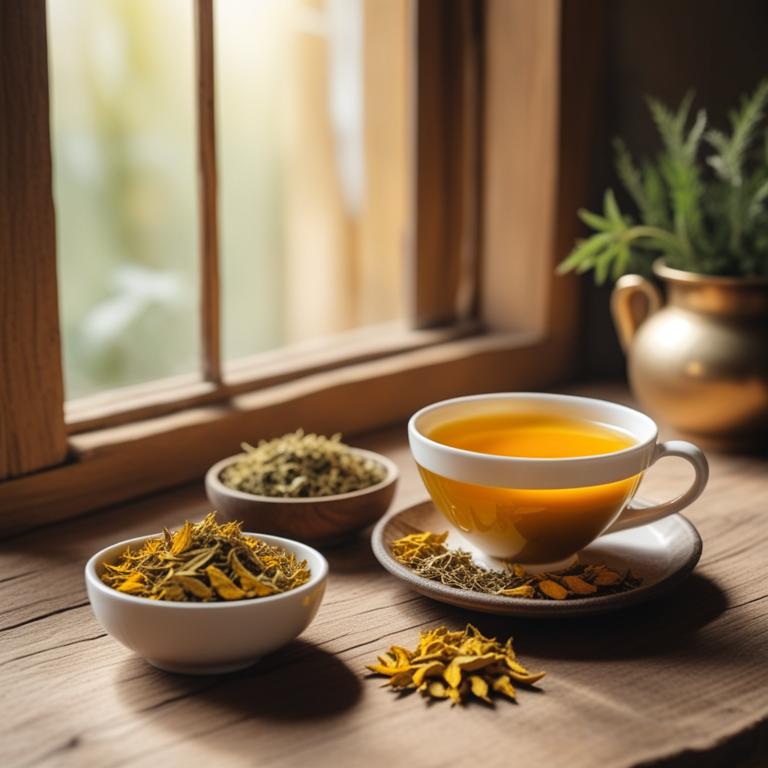
Curcuma longa teas, derived from the rhizome of the Curcuma longa plant, have been traditionally used to treat knee pain ailments due to their anti-inflammatory and antioxidant properties.
These herbal preparations help to treat knee pain by reducing inflammation, improving joint mobility, and alleviating pain, thus providing relief from symptoms associated with knee pain.
The bioactive constituents responsible for these benefits include curcuminoids, particularly curcumin, which has potent anti-inflammatory and antioxidant activities, as well as other compounds like turmerone and demethoxycurcumin.
The benefits of using Curcuma longa teas to treat knee pain include reduced dependence on pharmaceutical medications, fewer side effects, and improved overall well-being, making them a popular natural remedy for this common condition.
Related Study
According to "Current rheumatology reviews", Curcuma longa teas for knee pain may reduce symptoms and the extent of NSAID consumption, and enhance the quality of life, as suggested by 24 randomized trials involving 2399 women and men.
Recipe:
- Gather 1 teaspoon of dried Curcuma longa root and 1 cup of boiling water.
- Steep the Curcuma longa root in the boiling water for 5-7 minutes.
- Strain the mixture into a cup using a fine-mesh sieve or cheesecloth.
- Add 1 tablespoon of honey to the tea, if desired, for sweetness.
- Drink the tea 2-3 times a day, as needed, for relief from knee pain.
Curcuma longa teas can be an effective remedy for knee pain, but possible side effects may include stomach upset, diarrhea, and nausea due to the high content of curcumin, which can be irritating to the digestive system.
To use Curcuma longa teas safely, it is essential to consume it in moderation, avoid taking it on an empty stomach, and consider combining it with other herbs like ginger to reduce gastrointestinal discomfort.
Curcuma Longa Tea on Amazon
Pure Ceylon Turmeric Brew - 100% Organic Ceylon Turmeric Tea Bags (40 Sachets - pack of 2 – 20 COUNT PER BOX)
Disclaimer: We earn a commission if you click this link and make a purchase at no additional cost to you.
3. Glycyrrhiza glabra teas

Glycyrrhiza glabra teas have been traditionally used to treat knee pain due to their anti-inflammatory and analgesic properties, which help to reduce pain and inflammation in the affected area.
The herbal preparation helps to treat knee pain by inhibiting the production of pro-inflammatory enzymes and cytokines, thereby reducing the severity of pain and discomfort.
The bioactive constituents of Glycyrrhiza glabra teas, including glycyrrhizin, flavonoids, and saponins, contribute to their therapeutic effects, which help to alleviate knee pain and promote overall joint health.
The benefits of using Glycyrrhiza glabra teas to treat knee pain include reduced pain and inflammation, improved joint mobility, and enhanced overall well-being.
Recipe:
- Gather 1 tablespoon of dried Glycyrrhiza glabra root, 1 cup of boiling water, and a cup.
- Add the 1 tablespoon of dried root to the cup.
- Pour 1 cup of boiling water over the root in the cup.
- Let the mixture steep for 5-7 minutes, then strain it.
- Drink 1 cup of the tea, 2-3 times a day, as needed for knee pain relief.
Glycyrrhiza glabra teas can be used to treat knee pain due to its anti-inflammatory properties, but some individuals may experience side effects such as high blood pressure, potassium depletion, and increased risk of heart problems due to its high glycyrrhizin content.
Precautions should be taken when using Glycyrrhiza glabra teas, including limiting the duration of use to avoid prolonged potassium depletion and monitoring blood pressure levels, especially in individuals with pre-existing hypertension or cardiovascular conditions.
Glycyrrhiza Glabra Tea on Amazon
Pukka Herbal Teas Licorice and Cinnamon - 20 Bags, 20 Count
Disclaimer: We earn a commission if you click this link and make a purchase at no additional cost to you.
4. Cinchona officinalis teas
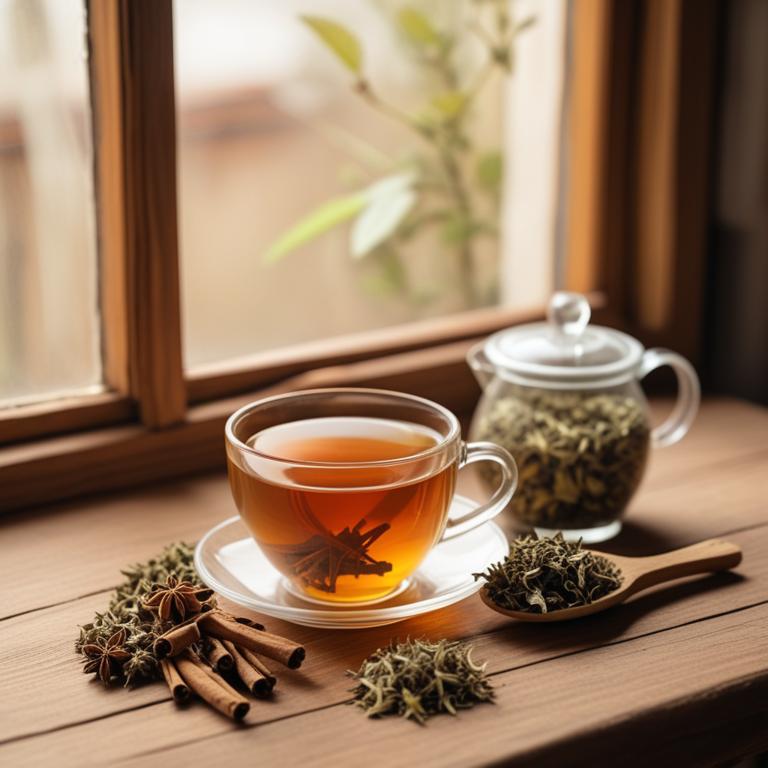
Cinchona officinalis teas have been used for centuries to treat knee pain, a common ailment caused by inflammation and damage to the joints.
This herbal preparation contains bioactive constituents such as quinine and alkaloids, which have anti-inflammatory and analgesic properties that help to reduce pain and swelling in the knees.
The quinine in Cinchona officinalis teas helps to inhibit the production of prostaglandins, which are hormone-like substances that promote inflammation, thereby relieving knee pain.
The benefits of using Cinchona officinalis teas to treat knee pain include reduced inflammation, relieved pain, and improved joint mobility, making it a natural and effective remedy for this common ailment.
Related Study
According to "Current rheumatology reviews", Cinchona officinalis teas may help reduce symptoms and the extent of NSAID consumption for knee pain, potentially enhancing the quality of life.
Recipe:
- Gather 1 cup of fresh Cinchona officinalis leaves or 2 teaspoons of dried leaves.
- Combine the leaves with 1 cup of boiling water in a teapot.
- Let it steep for 5-7 minutes, then strain the tea into a cup.
- Add 1 tablespoon of honey to sweeten the tea, if desired.
- Drink the tea 2-3 times a day for knee pain relief, or as directed by a healthcare professional.
Cinchona officinalis teas can be effective in treating knee pain due to their anti-inflammatory properties, but may cause side effects such as nausea, dizziness, and stomach upset in some individuals.
When using Cinchona officinalis teas to treat knee pain, it is essential to start with a low dose and gradually increase it to avoid over-stimulation of the heart, and to be cautious when consuming heavy meals or taking other stimulants simultaneously.
Cinchona Officinalis Tea on Amazon
Quina Roja(chinona) & Palo de Víbora Tea – 100% Natural, Vegan, Hecho en México | 25 Tea Bags
Disclaimer: We earn a commission if you click this link and make a purchase at no additional cost to you.
5. Ginkgo biloba teas
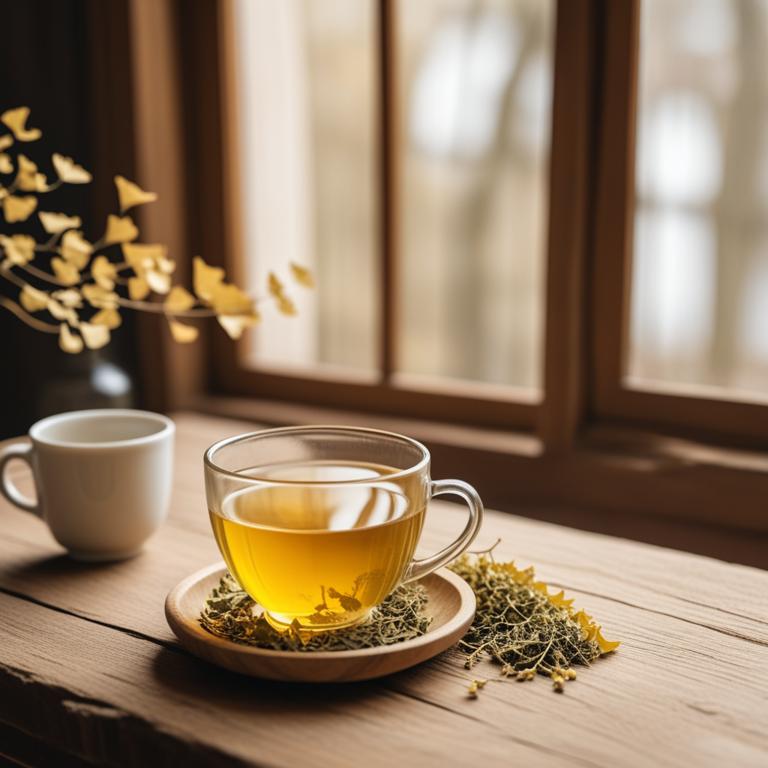
Ginkgo biloba teas have been traditionally used to treat knee pain due to its anti-inflammatory and antioxidant properties, which help to reduce inflammation and alleviate pain.
The herbal preparation contains bioactive constituents such as flavonoids and terpenoids, which have been shown to inhibit the production of pro-inflammatory mediators and promote the production of anti-inflammatory cytokines, ultimately leading to reduced pain and inflammation in the knee joint.
Drinking Ginkgo biloba tea may also help to improve blood flow and reduce oxidative stress, further contributing to its analgesic and anti-inflammatory effects.
The benefits of using Ginkgo biloba teas to treat knee pain include reduced pain and inflammation, improved joint mobility, and enhanced overall quality of life.
Recipe:
- Gather 1 cup of boiling water and 1 teaspoon of dried Ginkgo biloba leaves.
- Measure out 1 tablespoon of dried Ginkgo biloba leaves and place them in a tea infuser or a small muslin bag.
- Pour the boiling water over the Ginkgo biloba leaves in the tea infuser or muslin bag.
- Let the tea steep for 5-7 minutes, then remove the tea infuser or muslin bag.
- Strain the tea into a cup and drink it warm, 2-3 times a day, to help reduce knee pain.
Ginkgo biloba teas can be used to treat knee pain, but its possible side effects include dizziness, stomach upset, and allergic reactions in some individuals.
To minimize these risks, it's essential to consume Ginkgo biloba teas in moderation, monitor blood sugar levels, and avoid taking them with other medications, especially blood thinners, to prevent potential interactions.
Ginkgo Biloba Tea on Amazon
Tai Chi Think Sharp Energizing Tea (Ginseng Ginkgo Biloba) 12 Bags
Disclaimer: We earn a commission if you click this link and make a purchase at no additional cost to you.
6. Urtica dioica teas
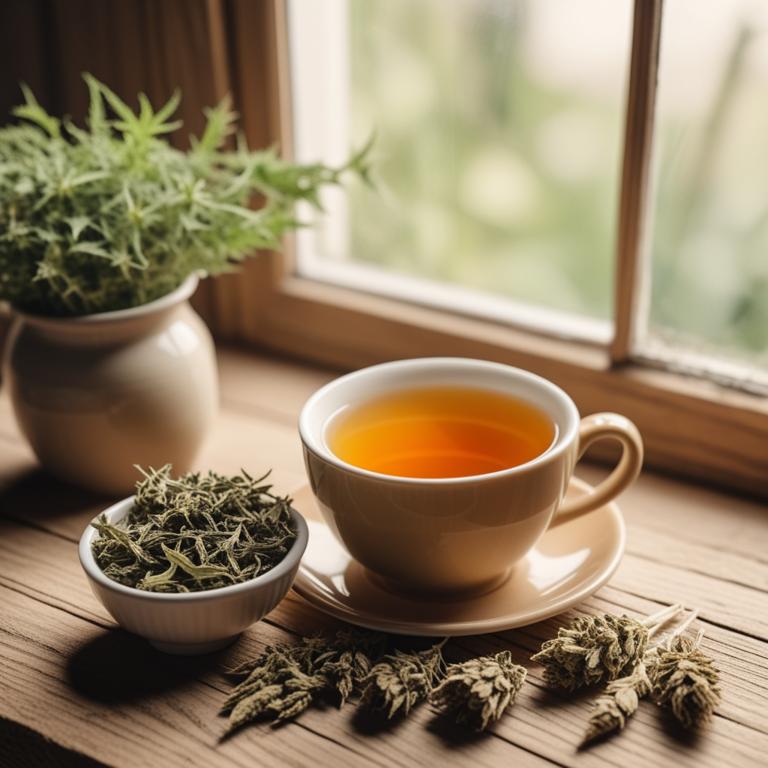
Urtica dioica teas, derived from the leaves and stems of the stinging nettle plant, have been traditionally used to alleviate knee pain due to their anti-inflammatory and analgesic properties.
The bioactive constituents present in Urtica dioica teas, including flavonoids, terpenoids, and phenolic acids, help to reduce inflammation and relieve pain in the affected area.
The herb's ability to inhibit the production of pro-inflammatory cytokines and enzymes contributes to its analgesic and anti-inflammatory effects, providing relief from knee pain and discomfort.
Regular consumption of Urtica dioica teas may also help to improve joint health and reduce the risk of chronic knee pain associated with conditions such as osteoarthritis.
Related Study
According to "Current rheumatology reviews", Urtica dioica teas for knee pain may reduce symptoms and the extent of NSAID consumption, and enhance the quality of life.
Recipe:
- Gather 1 cup of dried Urtica dioica leaves or 2 cups of fresh leaves.
- Measure 1 cup of water in a saucepan and bring to a boil.
- Add 1-2 teaspoons of dried leaves or 2-4 teaspoons of fresh leaves to the boiling water.
- Reduce heat and let it steep for 5-10 minutes. Strain the leaves.
- Drink 1/2 cup of the tea, 2-3 times a day, for knee pain relief.
Urtica dioica teas can potentially cause stomach upset and allergic reactions, such as hives or itching, when consumed to treat knee pain.
To minimize the risk of side effects, it is recommended to start with a small dose and gradually increase as needed, avoid consuming the tea on an empty stomach, and be cautious when using the tea in combination with other medications or herbal supplements.
Urtica Dioica Tea on Amazon
The Republic of Tea — Organic Nettle SuperHerb Tea Tin, 36 Herbal Tea Bags, Naturally Caffeine-Free
Disclaimer: We earn a commission if you click this link and make a purchase at no additional cost to you.
7. Equisetum arvense teas
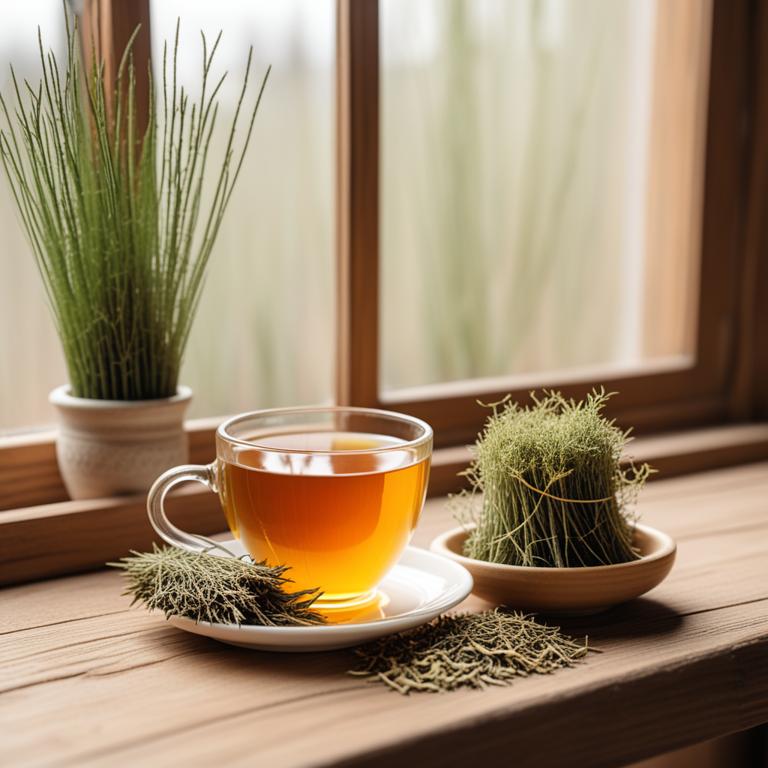
Equisetum arvense teas, also known as horsetail tea, have been used for centuries to treat knee pain ailments due to its anti-inflammatory, antioxidant, and analgesic properties.
This herbal preparation helps to treat knee pain by reducing inflammation and promoting healing in the joints, making it easier to move and perform daily activities.
The bioactive constituents of Equisetum arvense, such as silica, flavonoids, and alkaloids, contribute to its therapeutic effects by inhibiting the production of pro-inflammatory enzymes and promoting the production of anti-inflammatory compounds.
The benefits of using Equisetum arvense teas to treat knee pain include reduced pain and inflammation, improved joint mobility, and enhanced overall well-being, making it a popular natural remedy for individuals suffering from knee pain and arthritis.
Recipe:
- Gather 1 cup of fresh Equisetum arvense (horsetail) stems and leaves. Clean them with water.
- Chop the horsetail into small pieces. Use a tablespoon for measuring if needed.
- Steep 1 tablespoon of chopped horsetail in 1 cup of boiling water. Let it sit for 5-7 minutes.
- Strain the liquid into another cup. Discard the solids. Let the tea cool down.
- Drink the cooled Equisetum arvense tea for knee pain relief. You can repeat as needed, but not more than 3 times a day.
Equisetum arvense teas can be used to treat knee pain, but they may cause side effects such as digestive issues, allergic reactions, and interactions with other medications, particularly blood thinners.
To use this herbal preparation safely, it's recommended to start with small doses, monitor blood pressure and kidney function, and avoid using it with other stimulants or sedatives to minimize the risk of adverse effects.
8. Angelica sinensis teas
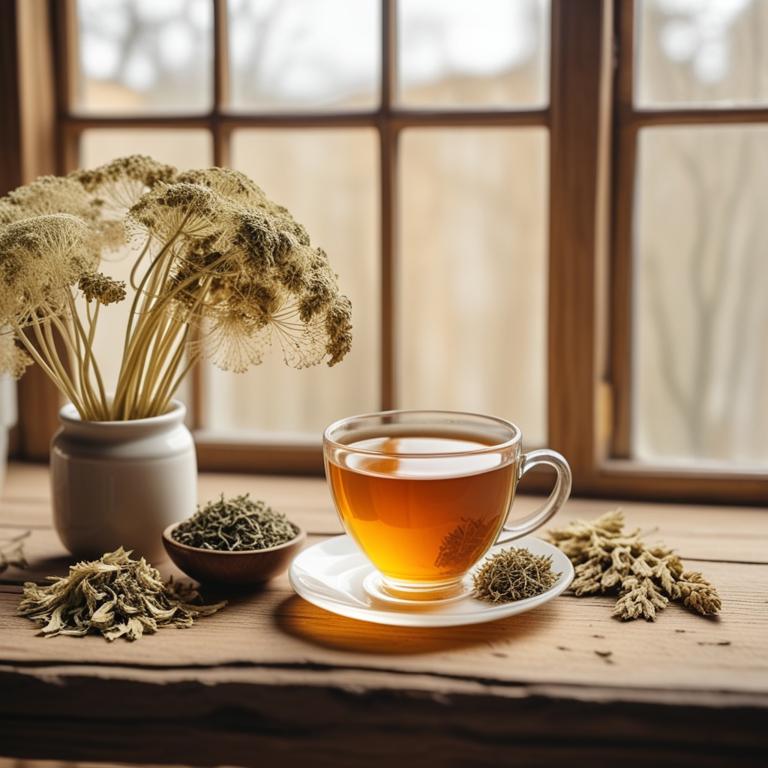
Angelica sinensis teas, also known as Dong Quai, have been widely used to treat knee pain and other musculoskeletal disorders due to their analgesic, anti-inflammatory, and antioxidant properties.
The herbal preparation helps to treat knee pain by reducing inflammation, relieving pain, and improving joint mobility, which in turn alleviates discomfort and promotes overall well-being.
The bioactive constituents of Angelica sinensis teas, including ferulic acid, isoflavones, and coumarins, contribute to their therapeutic effects by inhibiting pro-inflammatory enzymes and promoting the production of anti-inflammatory cytokines.
The benefits of using Angelica sinensis teas to treat knee pain include reduced pain and stiffness, improved joint function, and enhanced quality of life.
Related Study
According to "Frontiers in pharmacology", Angelica sinensis teas may be beneficial for knee pain due to its reported analgesic and anti-inflammatory actions from various studies on Angelicae Pubescentis Radix (APR), a Chinese medicinal herb also known as "Duhuo".
Recipe:
- Gather 2 tablespoons of dried Angelica sinensis roots and 1 cup of boiling water.
- Place the Angelica sinensis roots in a cup or teapot.
- Pour the boiling water over the Angelica sinensis roots.
- Steep the mixture for 5-10 minutes, then strain it.
- Drink 1/2 cup of the tea 2-3 times a day for knee pain relief.
Angelica sinensis teas can be beneficial in treating knee pain due to its anti-inflammatory properties, however, potential side effects may include stomach upset, allergic reactions, and interactions with blood thinning medications.
When using Angelica sinensis teas to treat knee pain, it is recommended to start with a low dose and gradually increase as needed, and to avoid consuming it with other medications that may interact with it, such as anticoagulants, and to be cautious when consuming it during pregnancy or breastfeeding.
9. Achillea millefolium teas
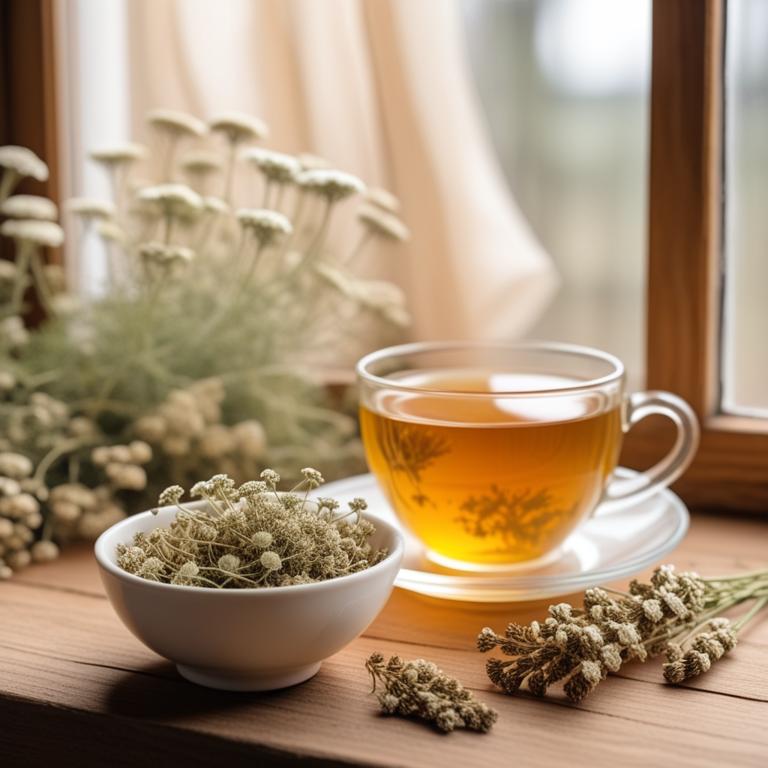
Achillea millefolium teas, also known as yarrow tea, have been traditionally used to treat knee pain due to their anti-inflammatory, antispasmodic, and antioxidant properties.
This herbal preparation helps to treat knee pain by reducing inflammation, relaxing muscles, and improving circulation, thereby alleviating pain and discomfort.
The bioactive constituents of yarrow tea, including flavonoids, phenolic acids, and sesquiterpenes, are responsible for its therapeutic effects, which include inhibiting pro-inflammatory enzymes and reducing oxidative stress.
The benefits of using Achillea millefolium teas to treat knee pain include reduced inflammation, improved joint mobility, and enhanced overall well-being, making it a popular natural remedy for individuals seeking alternative pain relief options.
Recipe:
- Gather 2 tablespoons of dried Achillea millefolium flowers or leaves.
- Measure 1 cup of boiling water in a teapot.
- Add the Achillea millefolium flowers or leaves to the boiling water.
- Let the mixture steep for 5-7 minutes, then strain it.
- Drink 1 cup of the tea, 2-3 times a day, for knee pain relief.
Achillea millefolium teas can be used to treat knee pain, but possible side effects may include dizziness, stomach upset, and interactions with blood-thinning medications.
Precautions to take include avoiding Achillea millefolium teas if pregnant or breastfeeding, and monitoring blood sugar levels if you have diabetes, as excessive consumption may cause blood sugar levels to drop.
Achillea Millefolium Tea on Amazon
Biokoma Pure and Organic Yarrow Dried Herb 30 Tea Bags 1.5oz In Resealable Moisture Proof Pouch, USDA Certified Organic - Herbal Tea, No Additives, No Preservatives, No GMO, Kosher
Disclaimer: We earn a commission if you click this link and make a purchase at no additional cost to you.
10. Silybum marianum teas
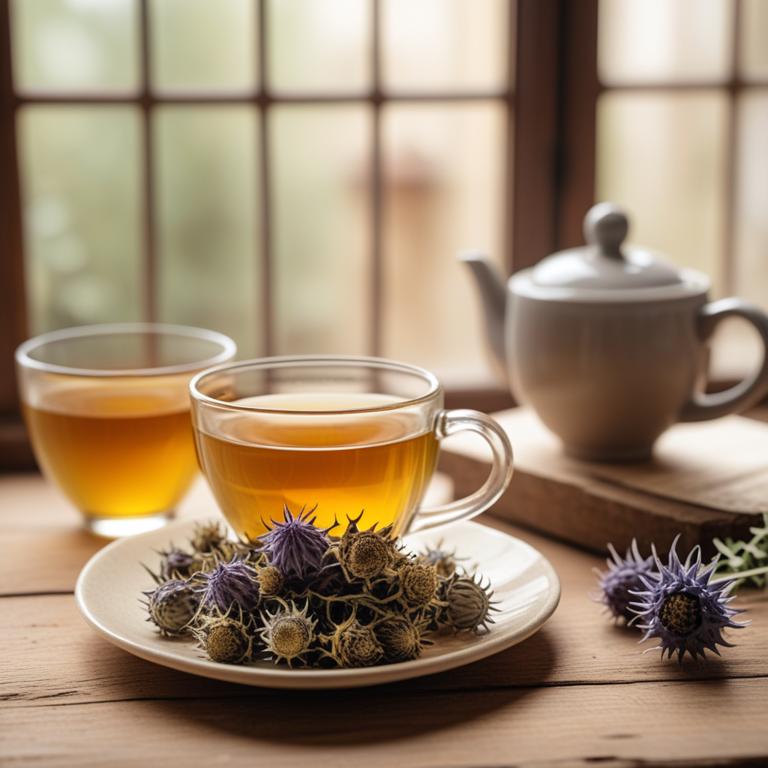
Silybum marianum teas, also known as milk thistle teas, have been used to treat knee pain due to their anti-inflammatory and antioxidant properties.
The herbal preparation helps to treat knee pain by reducing inflammation and pain in the joints, as well as improving the overall health of the connective tissues.
The bioactive constituents of Silybum marianum teas, including silymarin and flavonoids, have been found to have potent anti-inflammatory and antioxidant effects, which contribute to their pain-relieving properties.
The benefits of using Silybum marianum teas to treat knee pain include reduced inflammation, improved joint health, and a decrease in pain and discomfort, making it a potential natural alternative to conventional treatments.
Recipe:
- Gather 1 cup of Silybum marianum flowers (milk thistle) and 2 cups of water.
- Combine the flowers and water in a saucepan and bring to a boil.
- Reduce heat and let it simmer for 10-15 minutes.
- Strain the mixture into a cup using a cheesecloth or a fine-mesh sieve.
- Drink the tea 2-3 times a day to help with knee pain.
Silybum marianum teas can be used to treat knee pain, but they may cause side effects such as stomach upset, diarrhea, and allergic reactions in some individuals, particularly those with sensitive digestive systems or allergies.
When using Silybum marianum teas to treat knee pain, it is essential to start with small doses and gradually increase as needed, and to avoid consuming it before bedtime due to its potential to cause insomnia.
Silybum Marianum Tea on Amazon
Celebration Herbals Organic Milk Thistle Seed Herbal Tea -- 24 Tea Bags, NET WT.60, 2.11 OZ
Disclaimer: We earn a commission if you click this link and make a purchase at no additional cost to you.
11. Aloe barbadensis teas
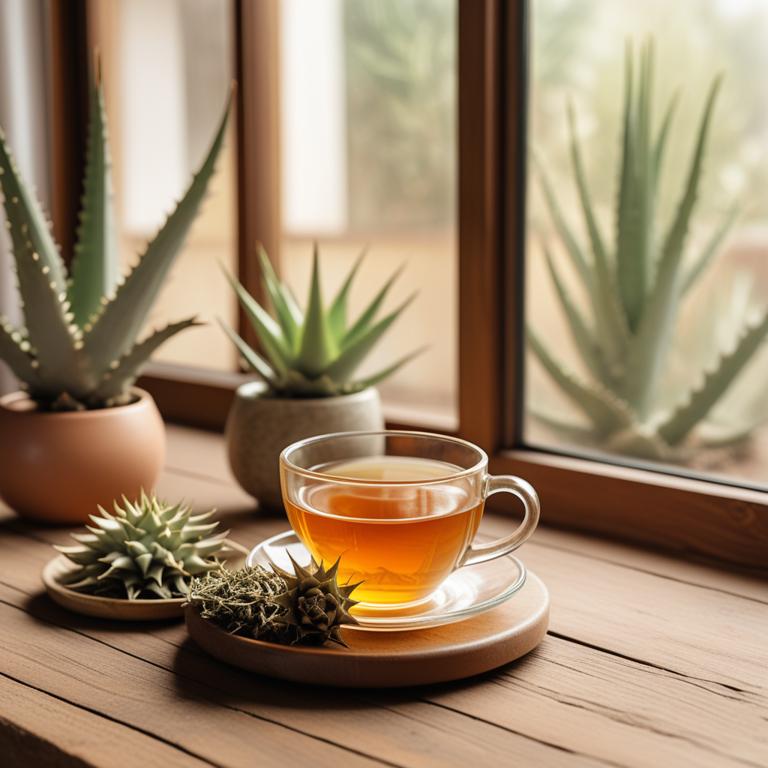
Aloe barbadensis teas have been traditionally used to treat knee pain due to their anti-inflammatory and analgesic properties, which help to reduce swelling and alleviate discomfort in the affected area.
The herbal preparation helps to treat knee pain by promoting blood circulation, reducing inflammation, and soothing irritated tissues, thereby providing relief from chronic pain and stiffness.
The bioactive constituents of Aloe barbadensis teas, including aloin, aloe-emodin, and vitamin C, possess potent anti-inflammatory and antioxidant properties that contribute to its therapeutic effects.
The benefits of using Aloe barbadensis teas to treat knee pain include reduced inflammation, improved joint mobility, and enhanced overall well-being, making it a popular natural remedy for managing this common ailment.
Related Study
According to the Journal of the American Podiatric Medical Association, Aloe barbadensis teas may be beneficial for knee pain as a 10% Aloe vera treatment reduced vascularity by 50% and the number of mast cells in synovial fluid by 48%, while stimulating the growth and repair of the synovial membrane.
Recipe:
- Gather 1 aloe leaf, 1 cup of water, and a blender or juicer.
- Cut the aloe leaf into small pieces and remove the thick outer skin.
- Blend or juice the aloe pieces with 1 cup of water until smooth.
- Strain the mixture through a cheesecloth or fine-mesh sieve into a cup.
- Drink the aloe tea 2-3 times a day for knee pain relief, or as directed by a healthcare professional.
Aloe barbadensis teas can be used to treat knee pain, but it may cause side effects such as stomach upset, diarrhea, and allergic reactions in some individuals, especially when consumed in large quantities or for extended periods.
To use Aloe barbadensis teas safely, it is recommended to start with small doses, avoid taking it with other medications, and be cautious of interactions with other health conditions, such as bleeding disorders or diabetes.
Aloe Barbadensis Tea on Amazon
The Republic of Tea Beautifying Botanicals® Clean Beauty Berry Aloe Herbal Tea Bags (36 count)
Disclaimer: We earn a commission if you click this link and make a purchase at no additional cost to you.
12. Echinacea purpurea teas
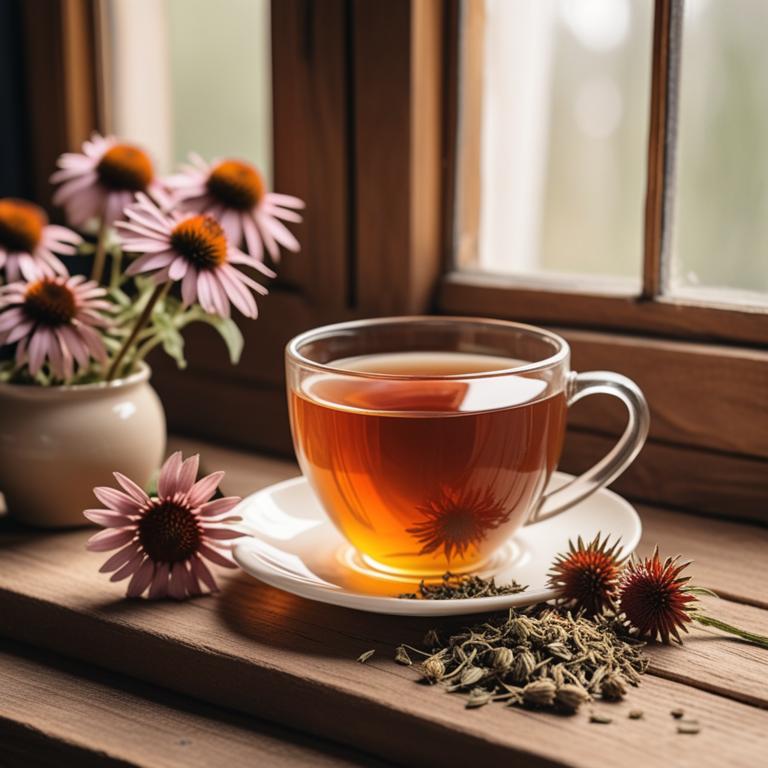
Echinacea purpurea teas have been traditionally used to treat knee pain, a common ailment caused by inflammation and oxidative stress.
The anti-inflammatory and antioxidant properties of this herbal preparation help to reduce pain and swelling in the knee joint.
The bioactive constituents, including alkylamides, caffeic acid, and flavonoids, work synergistically to inhibit pro-inflammatory enzymes and free radicals, thereby alleviating knee pain.
The benefits of Echinacea purpurea teas in treating knee pain include reduced pain and inflammation, improved joint mobility, and enhanced overall well-being.
Recipe:
- Gather 2 tablespoons of dried Echinacea purpurea flowers.
- Heat 1 cup of water in a pot until it starts boiling.
- Add the dried flowers to the boiling water and let it steep for 5-7 minutes.
- Strain the tea into a cup using a fine-mesh sieve or cheesecloth.
- Drink the tea once it has cooled down, 2-3 times a day for knee pain relief.
Echinacea purpurea teas can be used to treat knee pain, but possible side effects may include allergic reactions, digestive issues such as nausea or diarrhea, and interactions with blood thinners that may lead to bruising or bleeding.
When using Echinacea purpurea teas to treat knee pain, it's essential to take precautions, such as starting with small doses, avoiding use during pregnancy or breastfeeding, and being cautious of interactions with other medications, especially blood thinners, to minimize potential side effects.
Echinacea Purpurea Tea on Amazon
BLUE TEA - Chamomile Tea - Butterfly Pea Flower -18 Count - Pyramid Tea Bag | DETOX TEA | Caffeine Free - Flower Based - Vegan - Non-Bitter - Natural Ingredients | Tin Packaging
Disclaimer: We earn a commission if you click this link and make a purchase at no additional cost to you.
13. Corydalis yanhusuo teas

Corydalis yanhusuo teas have been traditionally used to treat knee pain and inflammation due to their anti-inflammatory and analgesic properties.
The bioactive constituents of Corydalis yanhusuo, including tetrahydropalmatine and berberine, help to inhibit the production of pro-inflammatory enzymes and reduce pain by blocking the transmission of pain signals.
This herbal preparation helps to reduce knee pain and inflammation by promoting blood circulation, reducing swelling, and relieving muscle tension.
The benefits of Corydalis yanhusuo teas for treating knee pain include reduced pain and inflammation, improved mobility, and enhanced overall well-being.
Recipe:
- Gather ingredients: 1 cup of water, 1 teaspoon of Corydalis yanhusuo root powder, and 1 tablespoon of honey (optional).
- Boil the water in a pot and let it cool for 5 minutes.
- Add 1 teaspoon of Corydalis yanhusuo root powder to the cooled water and stir well.
- Let the mixture steep for 5-10 minutes. Strain the liquid using a tea strainer or a fine-mesh sieve.
- Add 1 tablespoon of honey (if using) and stir well. Drink the tea while it's warm, 2-3 times a day.
Corydalis yanhusuo teas can provide relief from knee pain, but possible side effects may include dizziness, nausea, and stomach upset due to its sedative properties.
To minimize potential side effects, it is recommended to start with a low dosage, avoid consuming the tea before bedtime, and to monitor your body's response closely, especially when combining it with other medications or substances that may interact with its active compounds.